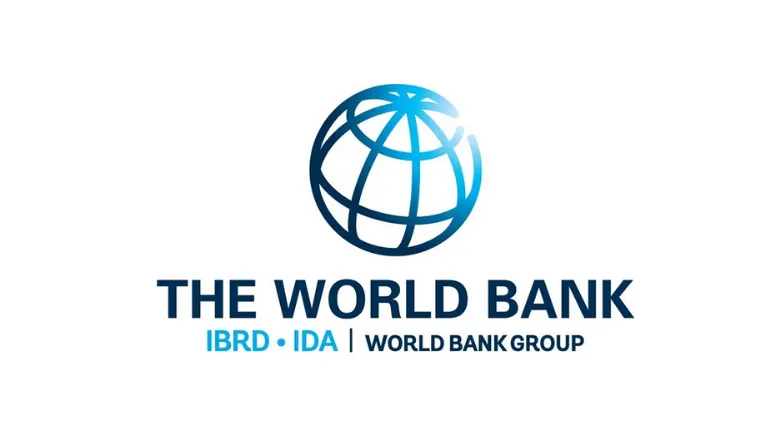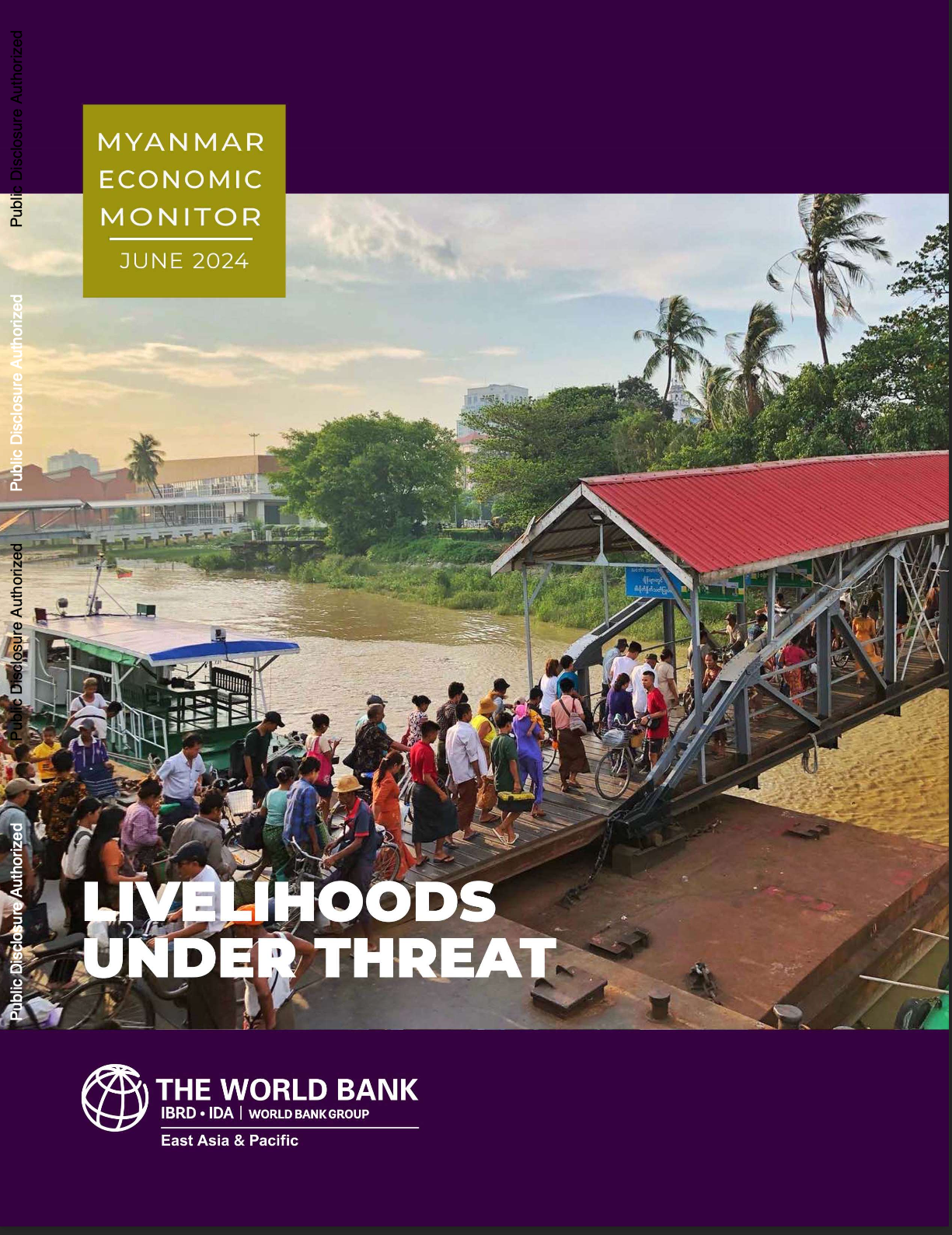Myanmar Economic Monitor : Livelihoods Under Threat
01 June 2024
The World Bank


Executive Summary
Myanmar’s economy continues to face significant challenges in 2024. Economic activity has been constrained by elevated conflict, increased macroeconomic volatility, and a challenging business environment. In addition to its ongoing impacts on household livelihoods and agricultural production, conflict continues to disrupt land border trade with China and Thailand, as well as domestic supply chains. The announcement of mandated conscription in February 2024 has intensified migration to rural areas and abroad, leading to increased reports of labor shortages in some industries. Moreover, since October 2023 more than one million people have been displaced by conflict, bringing the total number of internally displaced persons (IDPs) to 3.1 million as of early June. Kyat depreciation and lack of access to foreign currency and import licenses have led to persistent inflation and shortages of essential imported inputs. Electricity outages have worsened, compelling firms to rely on expensive diesel generators, thereby increasing production costs. About 33 percent of firms surveyed by the World Bank in April reported power outages to be their primary challenge, up from 12 percent in September.
Recent indicators of economic activity have been subdued. GDP is estimated to have risen by just 1 percent in the year ended March 2024, remaining around 10 percent below pre-pandemic levels. In the April 2024 round of the World Bank Firm Survey, firms reported operating at 65 percent of their capacity on average, a pick up from September 2023 but still 10 percentage points below levels a year earlier. The services sector, particularly retail and tourism, has suffered due to high inflation and reduced consumer spending power. Though there has been some shift toward sales of domestically produced products, retailers continue to face significant stock shortages. The number of international tourists also remains significantly below pre-pandemic levels and has weakened further since the beginning of the year, impacting the hospitality and related industries. As of March 2023, the manufacturing purchasing managers’ index had contracted for six consecutive months, as firms reported a drop in output and new orders, though these indicators subsequently improved in April and May. The agricultural sector has displayed signs of resilience, largely driven by increased input use and improvements in rice and other crop yields. However, limited access to credit and conflict-related disruptions to farming activities continue to weigh on agricultural production.
Reflecting anemic GDP growth, labor markets remain very weak. Following a marked deterioration in labor market conditions between 2017 and 2022—in terms of participation, employment, and formality—there has been only partial improvement over the year to end-2023.1 According to the World Bank’s Myanmar Subnational Phone Surveys (MSPS), the employment rate rose by 2.3 percentage points between the end of 2022 and the end of 2023, but remains 7.4 percentage points below 2017 levels. Meanwhile, the estimated adult unemployment rate rose from 6.7 percent to 8.1 percent over the year to end-2023. Measures of job vacancies – an indicator of demand for labor – have plateaued at well below 2020 levels. At the same time, some areas and industries have seen a reduction in labor supply, particularly in early 2024, due to labor movements within the country and across borders in response to conflict and fear of conscription. This combination of weakness in demand and supply has meant that real-time indicators of employment have deteriorated in recent months: in March 2024 the manufacturing purchasing managers’ employment index (an indicator of the direction of month-on-month changes in employment at the firm level) fell to its lowest level since 2021, and as of May employment in the manufacturing sector had contracted for each of the last 12 months.
There has also been a significant decline in trade, driven in large part by disruptions at key land border posts. In the six months to March 2024, merchandise exports fell by 13 percent and imports fell by 20 percent compared to the same period a year earlier. Excluding natural gas, exports through land borders declined by 44 percent, while manufactured exports – largely garments and natural gas – also fell sharply. Imports via land borders declined by half, accounting for 71 percent of the decline in overall imports. Trade with China and Thailand has been blocked or restricted at those border posts that have fallen under the control of resistance groups, but there is some evidence of redirection towards alternative land gates and sea trade. Import and foreign exchange restrictions, weaker domestic demand, and a shift toward domestic production also contributed to the decline in imports. Due to the large decline in imports, the merchandise trade deficit narrowed to nearly zero in the six months to March 2024.
The market exchange rate has depreciated sharply since the beginning of the year. The kyat has depreciated by about 20 percent against the US dollar on parallel markets since the end of 2023 (as of early June the exchange rate was around 4300 kyat per dollar). The spread between the official fixed reference rate and the parallel market rate tripled over the year to end May 2024, to more than 50 percent. Multiple exchange rates are in effect between the official reference rate and the market rate, with persistent shortages of foreign currency at non-market rates. In addition to CBM sales of foreign currency, vexchange rates. Several of have further reduced the availability of foreign have been deployed in an attempt to maintain a balance between foreign exchange supply and demand, including foreign currency surrender requirements, import license restrictions controls on non-trade related offshore payments, promotion of the use of foreign currencies other than US arious administrative measures barter transaction arrangements, dollars, and crackdowns on foreign exchange dealers not complying with regulated these measures (and the actions taken by businesses in response) currency, exacerbating depreciation pressures on the parallel market.
Inflation has remained persistently high, driven by rising food and fuel prices, and reflecting the impacts of kyat depreciation on the price of imported goods. Headline consumer price inflation rose to 30.4 percent (yoy) in September 2023, with both food and nonfood inflation increasing. Fuel and transport prices have risen further, due to both a pick-up in the global oil price and substantial pass-through from the depreciating exchange rate. Food inflation has also been driven by increased export prices, trade and logistics constraints, and disruptions in domestic production. More recent price indicators have continued to trend upwards since September: the World Food Program (WFP) index of food prices has risen by an average of 27 percent over the six months to April 2024, while diesel and gasoline prices have increased by 6 percent and 34 percent, respectively. There is significant variation across Myanmar with WFP data indicating that the increase in food prices in Kachin, Sagaing, and Rakhine has been markedly higher than in less conflict-prone regions such as Yangon. High prices in conflict areas reflect disruptions to transport infrastructure, road blockages, and the need to pay multiple road tolls and checkpoint fees, all of which act to compound pre-existing accessibility constraints. In addition, conflict has directly disrupted agricultural production in some parts of the country such as Sagaing and Rakhine, exacerbating food shortages and putting further upward pressure on prices. These trends have in turn contributed to food insecurity: according to an Food and Agriculture Organization (FAO) survey, a quarter of all Myanmar households were experiencing acute food insecurity in January 2024, 4 percentage points higher than what was reported six months earlier.
The fiscal deficit is expected to have widened in the year to March 2024. The fiscal deficit for FY2022/23 (year ended March) was smaller than expected, at 3.3 percent of GDP, with tax and non-tax revenues exceeding budget estimates, in part reflecting a moderate pick up of economic activities over that period. Nevertheless, Myanmar’s fiscal deficit is expected to have widened to 5.7 percent of GDP in FY2023/24 and is set to widen further to 6.1 percent of GDP in FY2024/25. Revenue collection is expected to have moderated from FY2022/23 levels, while the authorities have announced plans to increase current and capital spending on defense, education, health, electricity generation, transport, and agriculture. Public debt is projected to reach 63.0 percent of GDP in FY2024/25, only a small increase from previous years. High inflation has eroded the domestic debt stock in Myanmar (as a proportion of GDP) in recent years, partially offsetting the effects of relatively large budget deficits, negative or low real GDP growth, and the valuation effects of kyat depreciation on external debt.
Announcements
04 April 2025
Myanmar: Human Rights Council condemns the junta, responds to the earthquake, and calls to end sale and supply of arms and jet fuel
13 March 2025
Job Vacancy: Administrative and Finance Assistant
28 February 2025
Open letter: Removal of the membership of the dis-accredited Myanmar National Human Rights Commission from the Southeast Asia National Human Rights Institution Forum
25 February 2025
သတင်းထုတ်ပြန်ကြေညာချက် – တရားမျှတမှုဆီရှေးရှုလျက် အာဂျင်တီးနားတရားရုံး၏ ဖမ်းဝရမ်းထုတ်ပြန်မှုကို ကြိုဆိုထောက်ခံ
25 February 2025
Press Statement: Argentine Court’s arrest warrants are welcome progress towards justice

Progressive Voice is a participatory rights-based policy research and advocacy organization rooted in civil society, that maintains strong networks and relationships with grassroots organizations and community-based organizations throughout Myanmar. It acts as a bridge to the international community and international policymakers by amplifying voices from the ground, and advocating for a rights-based policy narrative.